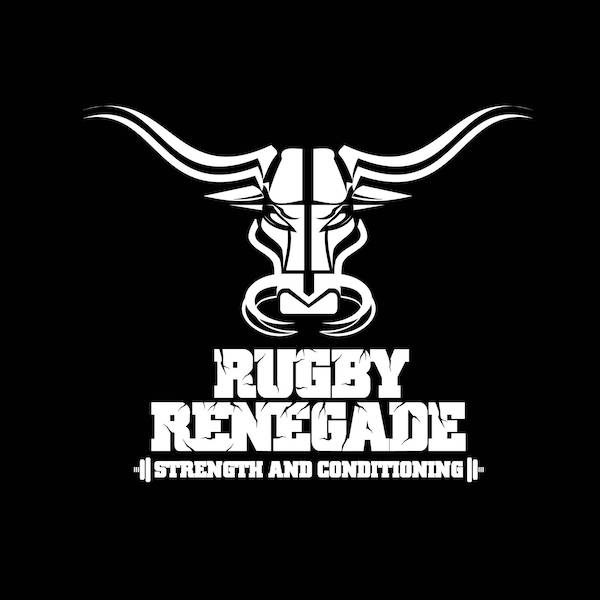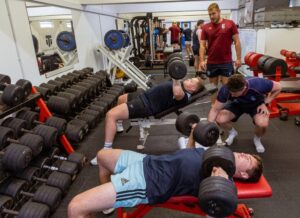Are you one of those Rugby Players who struggles to increase Muscle Mass? Regardless of training sessions you have followed from Men’s Health or Muscle and Fitness or nutrition plans that have promised you an increase in Muscle Mass of 5kg in 2 weeks.
Well I most certainly was. There was a time I’d wake up every morning and on the way to training drink 2 liters of water in a 10 minute window so that when it came to weighing in on arrival at training I was above the magic 100kg goal for me! In reality this was totally pointless and left me busting for the toilet every 2 seconds! Looking back I think it was sad that I felt this pressure of constantly being heavier, but as a player its needs must and its little things like bodyweight that at the time you think will be the difference between breaking a tackle and getting knocked around or even the difference in selection and non selection and you will do what ever it takes.
Rather than guzzling down 2 liters of water, lets talk about realistic ways rugby players can put themselves in optimal positions to gain weight in the correct circumstances. The point of this article is to get players to understand the roles and effects of Testosterone within the body…
Testosterone is key in Rugby Players, it is the most potent muscle-building hormone; and is directly involved in building muscle and promoting the secretion of Growth Hormone in the human body, another essential anabolic hormone for tissue repair and fat burning.
Optimal Testosterone levels will result in a lean body composition and low levels can lead to fat gain and muscle loss (muscle atrophy) not what we want as Rugby Players!
Additionally, low Testosterone levels are linked with reduced muscle mass, strength, and not to mention, a reduction in your sex drive!!! 
So what can Players do to help increase Testosterone levels?
Testosterone is typically measured in relation to cortisol, the catabolic, muscle-reducing hormone.
The best Testosterone response from training allows you to increase strength and lean body mass by elevating protein synthesis and reducing the catabolic effects from high-intensity training.
A higher Testosterone to Cortisol ratio reflects your ability to maintain a higher intensity and volume of training as well as have a speedier and more effective recovery from workouts. Naturally, if you can train harder and longer, you’ll get better results and improved performance.
Here are some ways that you can elevate your testosterone levels naturally and stack on some size as a result.
Warm-up With Sprints for the Greatest Anabolic Response
Prime the muscles and the endocrine system with all-out sprints prior to resistance training to lift more weight and get a better Testosterone: Cortisol ratio. Researchers have proven the importance of using large muscle lower body sprints and lifts for the most anabolic effect.
Heavy Compound Exercises – Clean, Squat, Deadlift, Press
It’s pretty common knowledge that for the biggest Testosterone increases, your best bang for your buck is to focus on the compound lifts (multi-joint) like Squats, Deadlifts, and Olympic Lifts such as Cleans and Snatches. A significant metabolic stress in the form of a high volume load, will see favourable increases in Testosterone to Cortisol ratio with compound lifts and volume of training.
Smash the Volume
Volume is key to eliciting Testosterone and Cortisol responses to training. Its been shown that strict maximal strength and power protocols produce only modest changes in anabolic hormone levels, while hypertrophy protocols commonly yield a significant hormone response.
For example, even with heavy lifts such as a 90 percent 1 RM load, you won’t get a significant Testosterone response without a large volume of work. Research shows that with a relatively higher volume of work, a hypertrophy-type (4 sets of 10 reps of squat at 75 percent of 1 RM) protocol is more effective at creating an anabolic effect than a strength-type (5 sets of 3 reps at 90 percent of 1 RM), or a power-type (5 sets of 5 reps of jump squats with no weight).
Training with a hypertrophy set/rep scheme resulted in significant increases in Testosterone and Cortisol indicating both a state of protein degradation and an adaptive process leading to increased protein synthesis. Workouts with a larger volume that incorporate specific strength and power lifts for variety would create the best anabolic response.
Which Rest Period is best?
While short rest periods with high-intensity training have been shown to create a potent anabolic environment by providing a strong Growth Hormone and Testosterone response, recent research shows that longer rest periods may be more effective in triggering Testosterone release if you program properly.
A new study compared the affect of rest period length on Growth Hormone and Testosterone response. Participants performed four sets to failure of bench press and squat at 85 percent of 1RM with either 60, 90, or 120 seconds of rest between sets. Because participants were lifting to failure, training volume for the 90- and 120-second rest groups was about 15 percent greater than for the 60-second group because they were more rested.
Testosterone levels increased the most with the longest rest period of 120 seconds, most likely due to the higher training volume because participants were able to recover more completely. The 60-second group had the highest increase in Growth Hormone, indicating the importance of using a variable training program that incorporates both short rest periods to stimulate Growth Hormone for and longer rest periods to get the critical Testosterone response. The slightly longer rest allows for the use of heavier loads and greater recovery between lifts, resulting in a higher total volume for the best Testosterone release.
Eat Healthy Fats
This means not only mono- and polyunsaturated fats, like that found in avocados and nuts, but also saturated, as these are essential for building testosterone. Diets with less than 40 percent of energy as fat (and that mainly from animal sources, i.e. saturated) lead to a decrease in testosterone levels.
It’s important to understand that your body requires saturated fats from animal and vegetable sources (such as meat, dairy, certain oils, and tropical plants like coconut) for optimal functioning, and if you neglect this important food group in favor of sugar, grains and other starchy carbs, your health and weight are almost guaranteed to suffer. Examples of healthy fats you can eat more of to give your testosterone levels a boost include:
- Eggs
- Coconut Oil
- Olive Oil
- Nuts
- Meats
- Butter
- Avocados
Take Branched-Chain Amino Acids for a Better Testosterone: Cortisol Ratio
BCAAs or branched chain amino acids are the three essential amino acids leucine, isoleucine and valine. These three amino acids, and in particularly leucine play a vital role in muscle protein synthesis (muscle growth) and recovery. BCAAs are a great addition to your water during training or a match and also a great option for those looking to lose fat. Its been proved that taking BCAAs while resistance training results in significantly higher Testosterone levels. When getting a BCAA supplement consider the Leucine concentration as important, this has been shown to result in greater anabolic protein signalling, which means less muscle breakdown from the degrading effects of Cortisol.
Get some Good Quality Sleep
Get some Sunlight….if you can!
 Getting out in the sun is a fantastic way to increase testosterone levels. Why? Because natural sunlight stimulates your body to produce vitamin D – which is actually more of a hormone than a vitamin despite the name and which has the main job of regulating the release of other hormones – including testosterone.
Getting out in the sun is a fantastic way to increase testosterone levels. Why? Because natural sunlight stimulates your body to produce vitamin D – which is actually more of a hormone than a vitamin despite the name and which has the main job of regulating the release of other hormones – including testosterone.
Vitamin D and sunlight is also closely tied to our sleep and by getting some time outside in the morning you will help your body to regulate its internal ‘body clock’. In turn this will ensure that you sleep more healthily and that will mean that you produce more testosterone and growth hormone during the night. Fresh air also helps with this. Plus sleep will give you more energy to attack your workouts the next day!
Want to Gain Muscle Mass for Rugby?
Check This Out:
[one_third last=”no”][/one_third][one_third last=”no”]
[/one_third][one_third last=”yes”][/one_third]
[separator top=”10″ bottom=”10″]
Rugby Renegade Subscribers benefit from an exclusive
40% discount code on all PAS Nutrition products!!
Simply use the following code at checkout….





